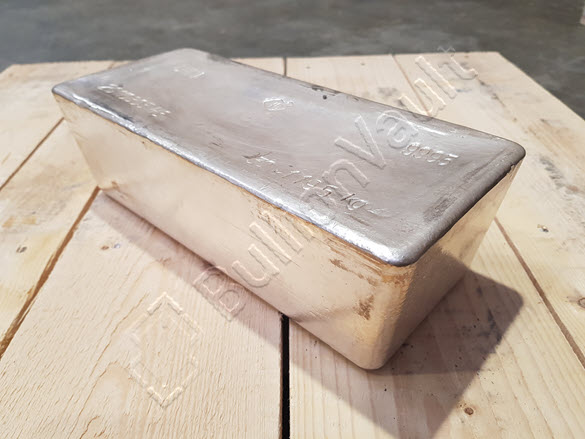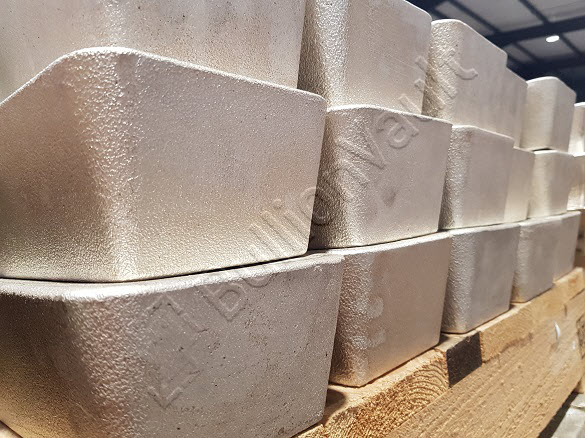Silver bars come in many different shapes and sizes. But as with most commodities, the larger the unit you buy, the better. Because buying in bulk will save you money, as you pay less for each ounce that the silver bar contains.
Due to silver's lower value against gold, there are many more companies that mint their own silver bars. The most expensive end of the range sees small "novelty" bars minted for the gift market. Tiny 5-gram and even 1-gram bars are promoted to US consumers at 7 or 8 times the cost of their silver content.
Cheapest of all, in contrast, are the large 1,000-ounce (32 kg) "Good Delivery" silver bars. Cast by a small group of accredited refiners, these bars are guaranteed to be .999 fine silver (meaning 999 parts per thousand, called "three nines" in the industry). Unlike gold, this metal is traded at gross weight by professional dealers in London and New York, centers of the world's 24-hour wholesale market. With silver being so much lower than gold by value, that one part per thousand of impurity is ignored in the price.
It's the live dealing in these 1,000-oz silver bars which creates the spot price you see quoted on the internet and in your newspaper. Smaller "retail" investment bars, like the silver used by industries including solar energy and chemical production, usually start life in one of those large Good Delivery bars, too. That's where manufacturers find the guaranteed quality and lowest costs which the wholesale market delivers.

There are many hundreds of different types and sizes in the retail silver investment bar market. But for US and European investors, the most common sizes are 1, 10, and 100 ounce silver bars. Smaller bars are punched out of a sheet (itself produced from metal typically bought and stored in the form of large Good Delivery bars) and then stamped on both sides. Bars weighing 100 ounces or more are usually poured as molten silver, melted from a 1,000-oz bar, into a mold. These bars are then struck, once cool, with the name of the refiner, the gross weight, and the purity.
Silver bars weighing 50 or 100 ounces may also be produced by what's called "extrusion". This process, working as a child's toy might with clay or dough, pushes the silver into shape by forcing it through a machine called an extruder. This produces cleaner-looking bars, but these have in the past been targeted by fraudsters for hollowing and filling with much cheaper lead.
The large Good Delivery bars, in contrast, are all poured bars. This gives their surface a unique, very slightly "pitted" look, making it far harder to cut open and re-seal them without it being obvious.
Compared to these 1,000-oz silver bars, the prices of all smaller units carry high premiums to cover the extra manufacturing costs. Retail distribution costs add to your price again, meaning you'll pay significantly over the wholesale spot silver price. One-ounce silver bars are typically cheaper than 1-oz silver coins. But the dealing spread (between the price you pay to buy and the price a retailer will pay when you sell) still runs to 10% or more. Even on bulk purchases of larger retail bars, such as 10 bars of 500-oz each from the leading US dealers, the gap between sale and re-purchase prices will exceed 4%.
A further cost in Europe and some US states is sales tax. In the European Union, VAT is excluded from gold bars. But silver is still deemed to be an "industrial" metal, and so is subject to Value Added Tax. This is levied at 20% in the UK, and paid by the buyer. Private individuals cannot reclaim that tax when they sell. So this effectively widens the dealing spread again, pushing it out to 30% and more for investors who buy smaller silver bars.
Because the UK government knows London's importance to the global market, however, silver held in Good Delivery form avoids VAT if the bars remain inside accredited vaults, controlled by a professional market member. BullionVault is a member of the London Bullion Market Association. So its customers, who can trade metal held inside large Good Delivery bars down to 1 gram at a time, aren't liable to HMRC, the UK tax authority. Not unless and until they choose to withdraw their silver from the vault. The same is true of the other 3 locations where BullionVault users can trade silver. There is no sales tax due in Singapore, Toronto or Zurich, provided that you leave your silver inside the care of the specialist, independent vaults we employ.
To retain Good Delivery status, the big 1,000-ounce bars traded by refineries, mints, wholesalers, bullion banks and industrial users must remain inside secure, recognized bullion vaults. Take these silver bars out of market-approved storage - even to store at your bank - and they instantly lose the "integrity" that guarantees each bar's silver. Because each bar, held inside accredited storage, has a clear record of ownership running back to the original fabricator. Any problems would be resolved by the original producer.

It's the integrity of Good Delivery silver bars that ensures maximum resale when you come to sell. But until recently, private investors couldn't access this market unless they were able to buy a whole 1,000-oz bar. Nor could they arrange market-approved storage unless they owned five big bars or more.
At BullionVault, however, you can now buy as little as one gram at a time of Good Delivery silver. Stored in market-approved silver bar facilities, your silver will retain its maximum resale value. Storage fees for owning a portion of these big silver bars - whether in London, Singapore, Toronto or Zurich - run as low as 0.48% per year, with insurance included.
To learn more now, and to register for 4 grams of free silver held securely in Zurich, Switzerland, click through to BullionVault here...






